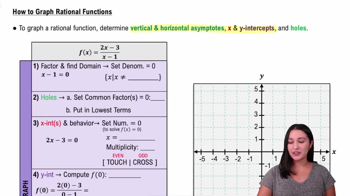Here are the essential concepts you must grasp in order to answer the question correctly.
Vertical Asymptotes
Vertical asymptotes occur in rational functions where the denominator equals zero, leading to undefined values. To find vertical asymptotes, set the denominator of the function to zero and solve for x. These asymptotes indicate values where the function approaches infinity or negative infinity, creating a boundary that the graph cannot cross.
Recommended video:
Determining Vertical Asymptotes
Horizontal and Slant Asymptotes
Horizontal asymptotes describe the behavior of a function as x approaches infinity or negative infinity. They are determined by comparing the degrees of the numerator and denominator. If the degree of the numerator is less than the denominator, the horizontal asymptote is y=0. Slant (or oblique) asymptotes occur when the degree of the numerator is exactly one more than that of the denominator, and can be found using polynomial long division.
Recommended video:
Determining Horizontal Asymptotes
Graphing Rational Functions
Graphing rational functions involves plotting key features such as intercepts, asymptotes, and behavior at infinity. After identifying vertical and horizontal/slant asymptotes, one can determine the function's behavior near these lines. Additionally, finding x-intercepts (where the numerator equals zero) and y-intercepts (by evaluating the function at x=0) helps create a complete picture of the graph's shape and behavior.
Recommended video:
How to Graph Rational Functions
 Verified step by step guidance
Verified step by step guidance Verified video answer for a similar problem:
Verified video answer for a similar problem:



 5:31m
5:31m